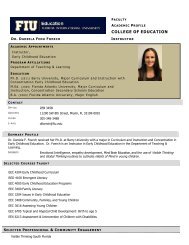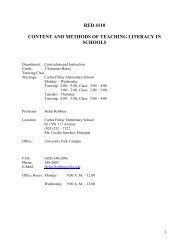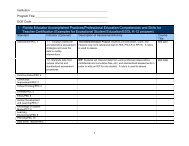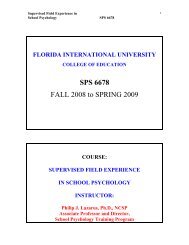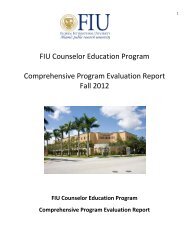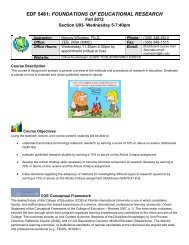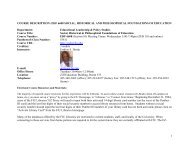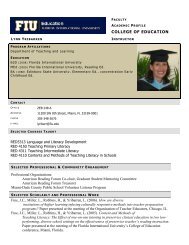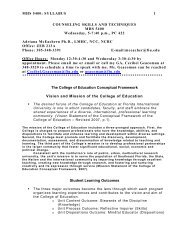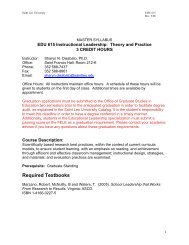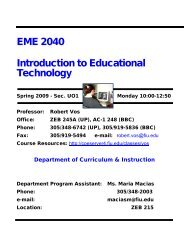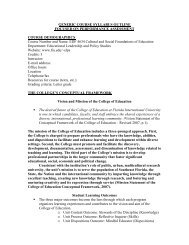2007 - College of Education - Florida International University
2007 - College of Education - Florida International University
2007 - College of Education - Florida International University
Create successful ePaper yourself
Turn your PDF publications into a flip-book with our unique Google optimized e-Paper software.
Discussion<br />
Urban special educational programs in inner cities face unique challenges. The design <strong>of</strong><br />
appropriate educational programs for urban special education students needs to be examined.<br />
Morse (2001) provides reasons why educational programs should meet the needs <strong>of</strong> this<br />
population. Morse addresses the fundamental differences between urban schools ands rural or<br />
suburban schools, focusing on the labeling <strong>of</strong> students in urban special education and the<br />
evolution <strong>of</strong> their disabilities. Urban special education students differ from their peers in that<br />
they require a more extensive form <strong>of</strong> instruction that involves authentic, culturally relevant<br />
activities to meet their individual needs. Additionally, students in urban schools are susceptible<br />
to at-risk factors, such as poverty, single parent households, higher dropout rates, and parents<br />
with a lowered educational level.<br />
Standardized Assessment and African American Students<br />
Race as an academic achievement predictor is important when determining the<br />
appropriate assessments to use for authentic assessments. Traditionally, schools systems track<br />
performance on achievement test by race (African American, Hispanic American, Native<br />
American, Asian American, and White) to compare different groups <strong>of</strong> students and their<br />
performance on standardized assessments. African American and Hispanic students are at a<br />
disadvantage compared to their White peers on achievement tests. The knowledge <strong>of</strong> being tested<br />
on their academic abilities (stereotype threat) inhibits African American students from<br />
performing at higher achievement levels (Bainbridge & Lasley, 2002). In a study comparing<br />
reading and math performance <strong>of</strong> African American and European American students in Ohio’s<br />
urban districts the big eight average (Akron, Canton, Cincinnati, Cleveland, Columbus, Dayton,<br />
Toledo, and Youngstown), African American students’ reading performance was an average <strong>of</strong><br />
28.5%, where White students performed an average <strong>of</strong> 36.9%. In math African American<br />
students performed 16.3% on average whereas White students performed at 41.0% (Ohio<br />
Department <strong>of</strong> <strong>Education</strong>, 1999). These discrepancies continue to support the gap in achievement<br />
between African Americans and their White peers. The implications for African American<br />
student are critical and students need to be exposed to high quality, well-designed assessments<br />
that take into consideration the risk factors associated with certain racial groups. Designing<br />
appropriate authentic assessments will aid in lessening the gap in performance <strong>of</strong> students from<br />
different races.<br />
Authentic Assessment: Steps to Creating Achievement in African Americans<br />
Authentic assessments provides for modification <strong>of</strong> curricular forms <strong>of</strong> assessments that<br />
alters the assumed outcome <strong>of</strong> African American learners (as to prevent harm or improve their<br />
academic achievement). Creating appropriate alternative assessments for African American<br />
students involves the following steps. The first step involves an intervention that focuses on<br />
redesigning the urban school by incorporating a school-wide implementation <strong>of</strong> culturally<br />
responsive practices, such as teacher dialogue, student cultural activities, and parental<br />
involvement. Next, schools must infuse authentic assessments that involve content-rich<br />
pedagogy that is relatable for minority, high-poverty or urban poor populations and focus on the<br />
curriculum, assessments, teachers, and systems to monitor students progress (see Table 3).<br />
Finally, designing instructional practices, such as a comprehensive curriculum, in which goals,<br />
objectives, and parental input and involvement are aligned with the diversity <strong>of</strong> students’ cultures<br />
and learning styles provides for a more appropriate means <strong>of</strong> providing a quality education for<br />
African American children at risk for special education in urban settings.<br />
21



